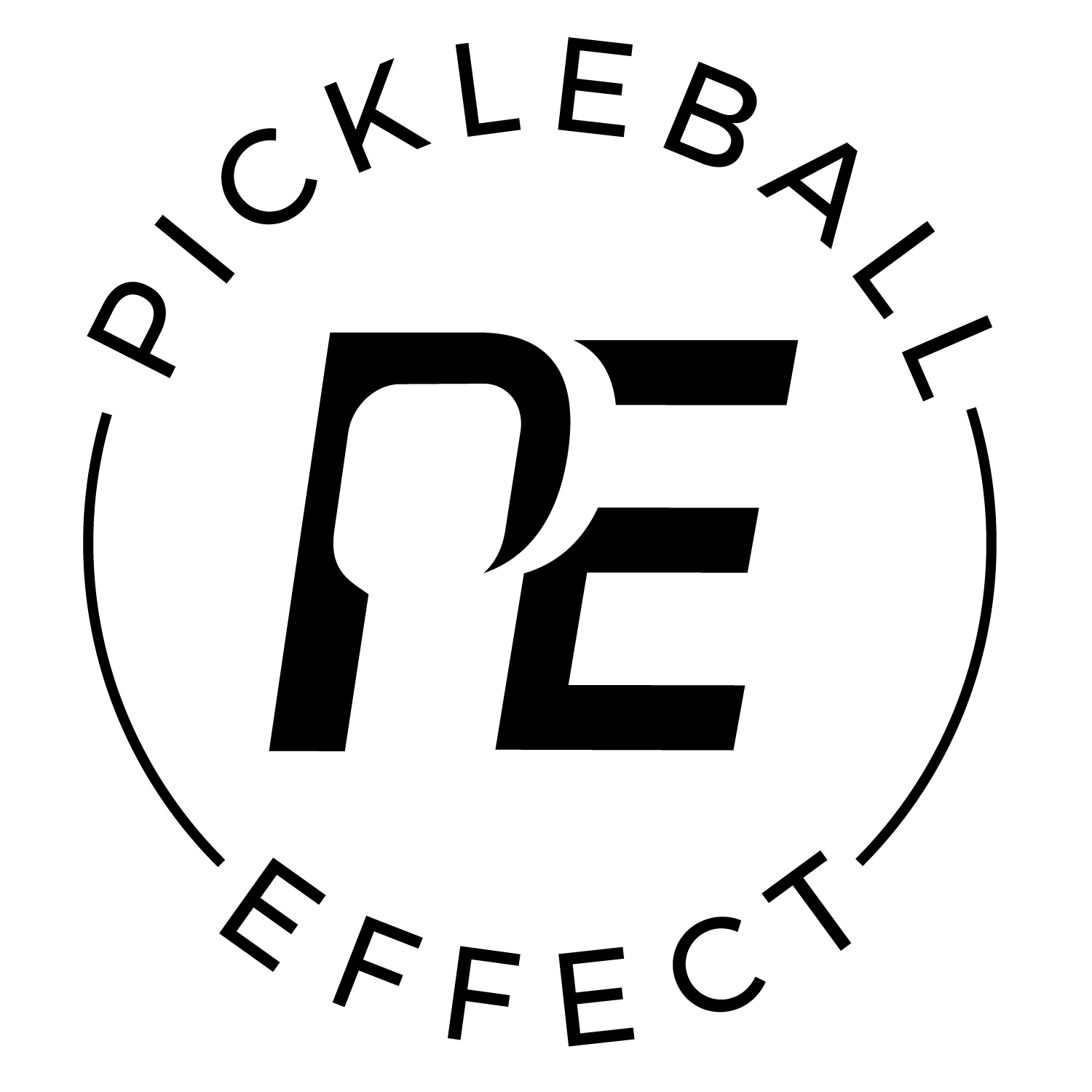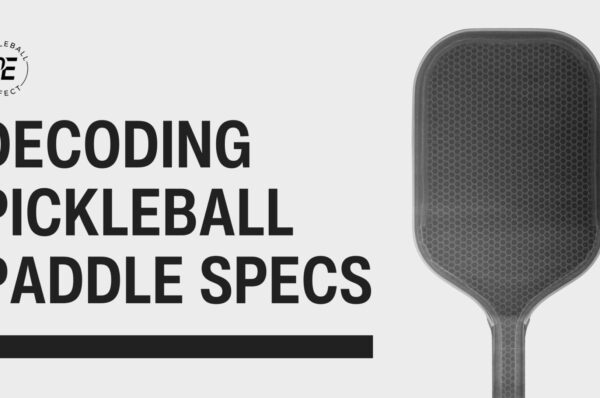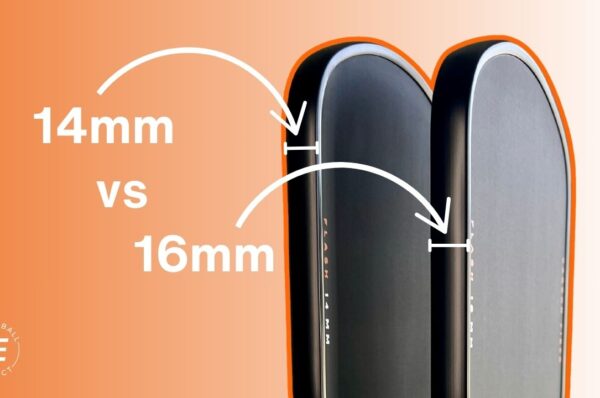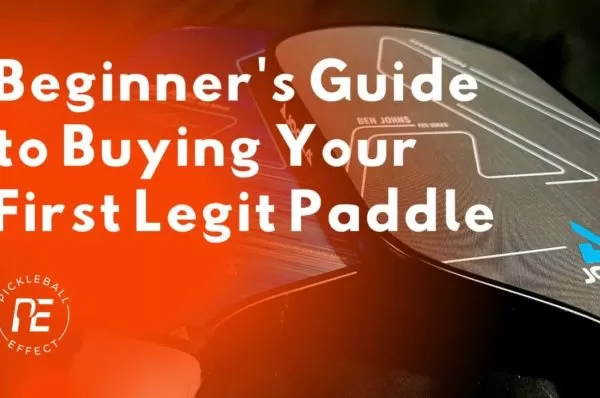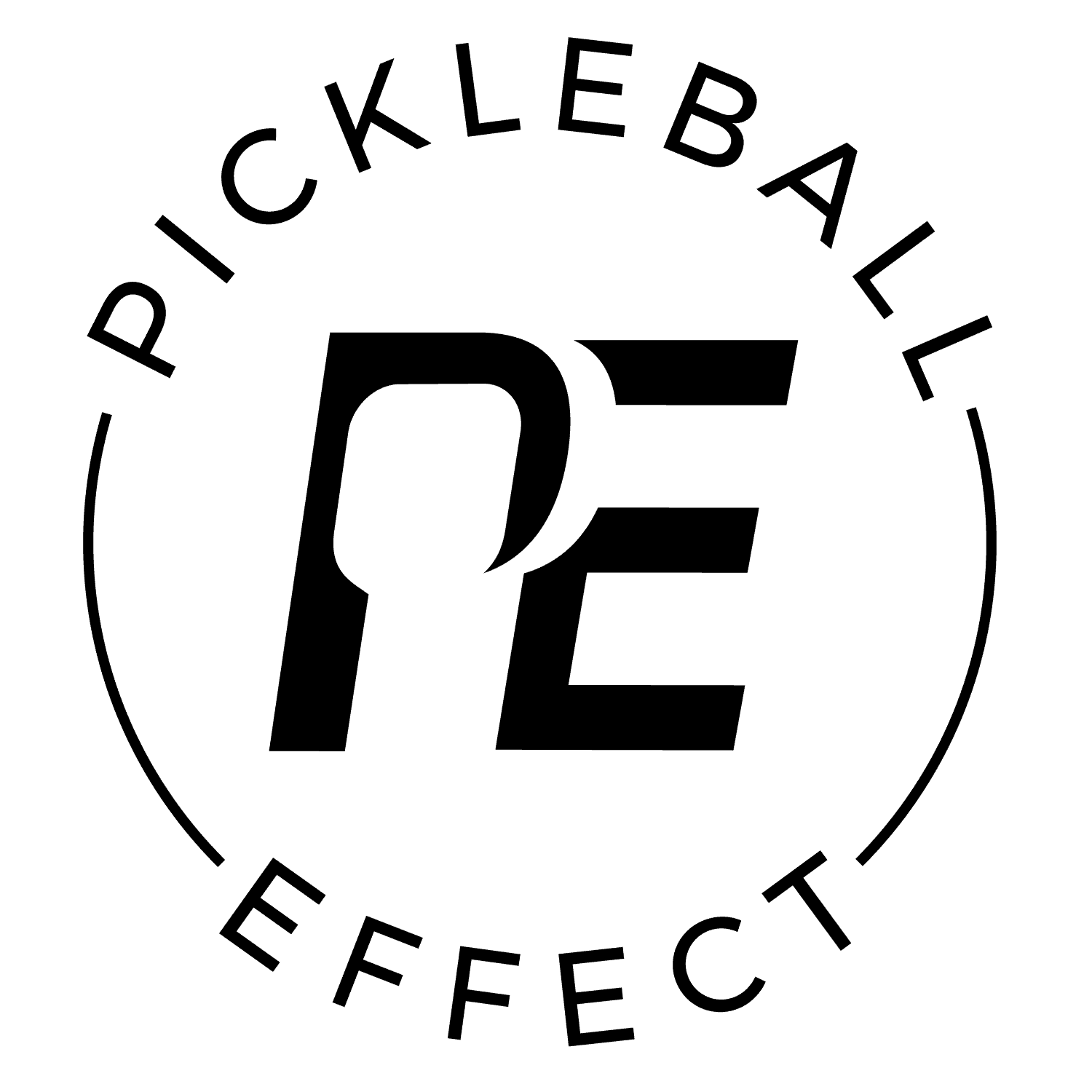To play your best pickleball, it’s crucial to select a paddle that aligns with your playstyle, amplifies your strengths, and minimizes your weaknesses. But it’s hard to find that paddle with so many different options and every brand claiming their paddles are perfect for everyone which simply isn’t true. The best way to cut through the marketing noise and pick the best paddle for you is to identify what you need and learn how to match the corresponding paddle specs and data to what you need. Which is exactly what I’m going to show you how to do.
In this guide, I will walk you through five practical steps on how to choose the best pickleball paddle for you and explain how to use my paddle database to narrow down your options based on your takeaways from these steps.
- Choosing the right paddle type
- Choosing the right paddle shape
- Choosing the right handle length
- Picking the optimal swingweight and twistweight
- Using my paddle database to narrow your options
Table of Contents
Step One: Choosing the Right Paddle Type
Paddles can be categorized into three different types or categories. Control, all-court and power. Here’s a description of each type. Pick the type of paddle that best fits what you’re looking for and hold onto it for later.
1. Control
Control paddles are designed to absorb pace and provide superior control when executing softer shots like drops, dinks, and resets. The paddles offer a larger sweet spot and greater forgiveness, which can enhance consistency and reduce errors. However, one drawback is their limited power and reduced ability to generate offense.
2. All-Court
All-court paddles are designed to provide a balanced blend of power and control. A good all-court paddle is characterized by attributes such as a harmonious combination of power, control, good feel, spin, and forgiveness. While not excelling in any specific area, these paddles are versatile and perform well in all aspects.
3. Power
Power paddles are specifically designed to enhance the offensive aspect of your game. A good power paddle is characterized by attributes such as power, pop, spin, and maneuverability. Although using a power paddle grants you more offensive capabilities, it comes at the cost of sacrificing control and forgiveness.
My Recommendation
There are many factors that determine whether a paddle is classified as a control, power, or all-court paddle, which we won’t delve into. You just need to decide which style of paddle suits you best.
I recommend a control type paddle if you’re newer to the game or if you need help keeping the ball down and controlling placement. Mastering soft shots like drops, resets, and dinks is often the most challenging part of the game, and a control paddle makes executing those shots easier. Many professional players also opt for control type paddles so if you’re an advanced player that can generate your own power then you may still benefit from the extra forgiveness and consistency of a control paddle.
For those with an already developed soft game or those who need assistance in generating power to finish points, I recommend an all-court type paddle. All-court paddles are popular at all levels of play as they offer offensive capabilities without sacrificing too much control and forgiveness. If you’re unsure about which paddle type to choose, an all-court paddle is a safe option.
I recommend power type paddles less frequently, although they certainly have their place. If you have an aggressive playing style and enjoy driving the ball and attacking whenever possible, a power paddle is a good choice for you. A good power paddle provides extra power and speed, giving you the advantage when attacking and finishing points. However, they can be more challenging to control and usually have smaller sweet spots.
Get 10% Off Paddles, Shoes & Gear
We've partnered with Fromuth Pickleball to give you 10% off paddles, shoes and gear. Some Exclusions apply.
Code: 10EFFECT
SHOP NOWStep Two: How to Choose the Right Paddle Shape
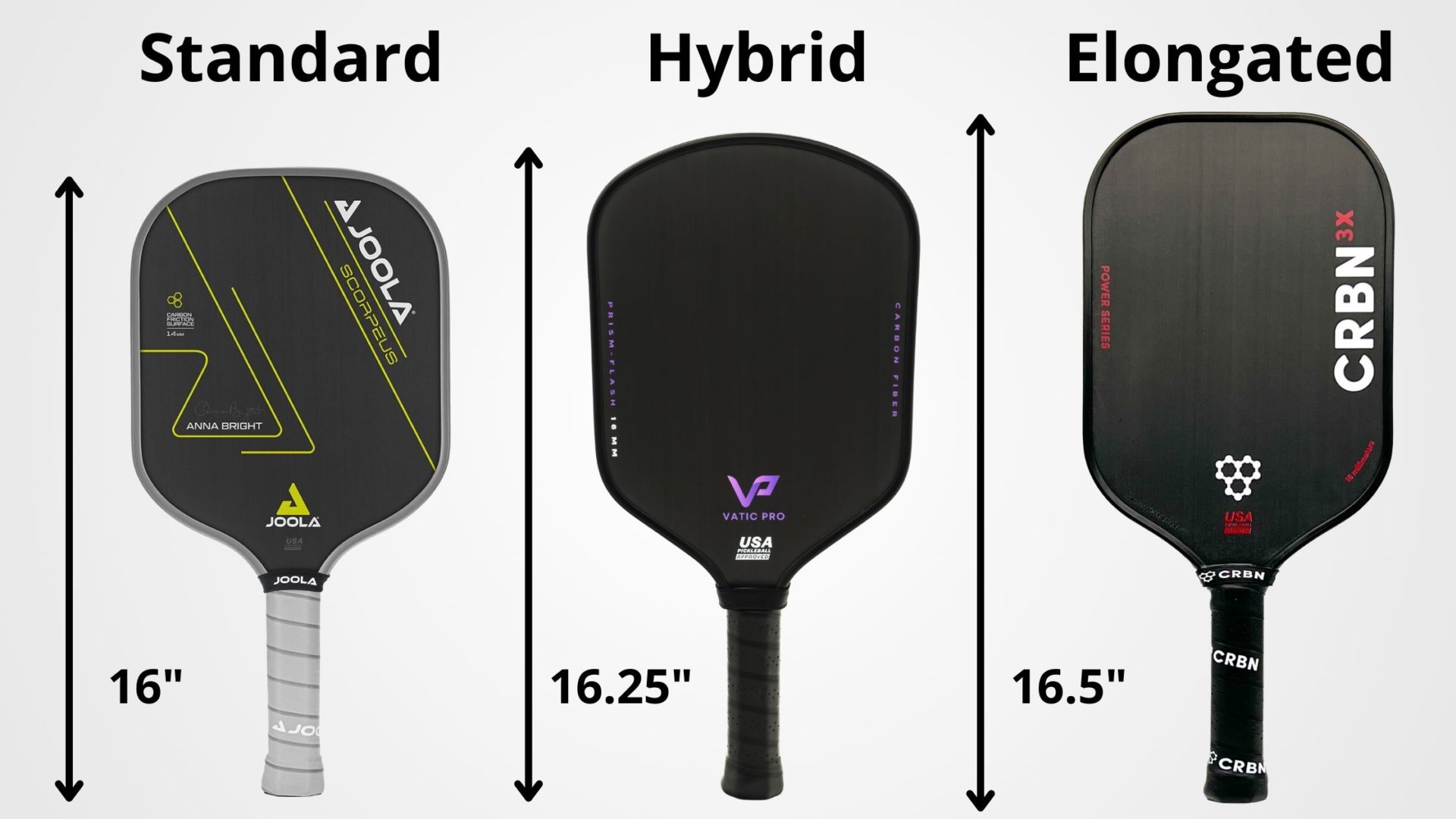
The shape of a paddle refers to its length and width. According to USAP rules, the combined total length and width of a paddle cannot exceed 24 inches. As paddles become longer, they also become narrower, and as they become shorter, they become wider. Within these guidelines, three general paddle shapes have emerged: standard, elongated, and hybrid. Let’s explore each shape and their individual benefits to help you select the one that best suits your needs.
Paddle shape dimensions:
- Elongated: The dimensions for an elongated paddle are 16.5″ x 7.5″.
- Standard: A standard shaped paddle has dimensions of 16″ x 8″.
- Hybrid: A hybrid shaped paddle falls somewhere in between the standard and elongated shapes, with approximate dimensions of 16.25″ x 7.5-7.7″.
Characteristics of each paddle shape:
- Elongated: An elongated paddle offers increased reach, spin, and power. However, this additional reach comes at the expense of forgiveness, particularly from side-to-side.
- Standard: In contrast, a standard-shaped paddle provides less reach and a little less power & spin but offers greater overall forgiveness. This means that while you may not have the same extended reach as an elongated paddle, you gain better control and stability.
- Hybrid: The hybrid shape serves as a middle ground between the elongated and standard shapes. It provides a balance between reach and forgiveness, offering players a versatile option that combines aspects of both shapes.
- Extra-elongated: 17″ x 7″.
- Widebody: Anything under 16″ in length.
My Recommendation
It’s worth noting that advanced players tend to prefer elongated shapes, whereas players at lower skill levels often opt for the extra forgiveness offered by standard-shaped paddles. Ultimately, the ideal paddle shape for you depends on your playing style, personal preferences, and skill level. By taking into account the advantages and trade-offs of each shape as described above, you can make an informed decision on which paddle shape will work best for your playing style.
Step Three: How to Choose the Right Handle Length
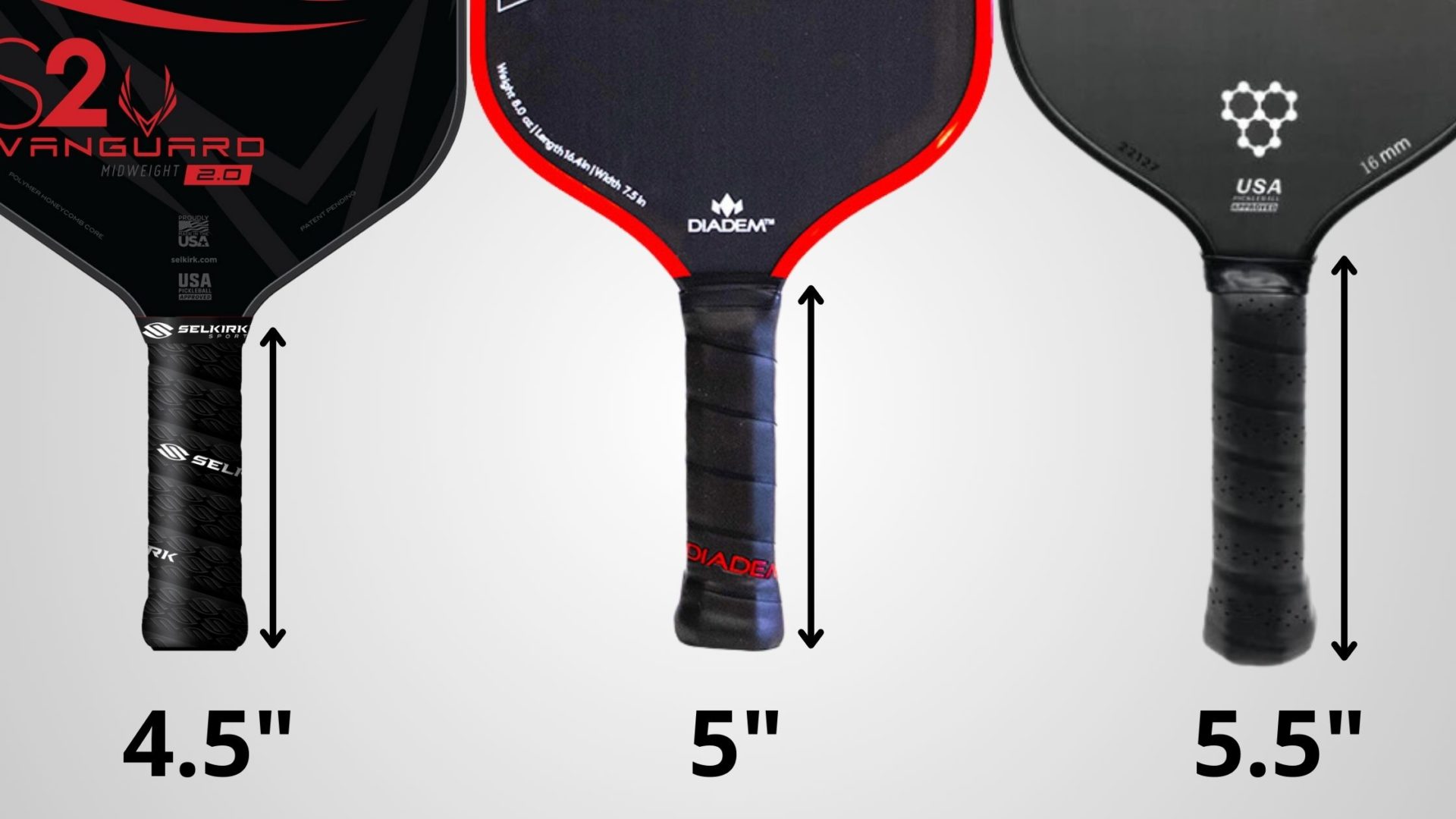
Another important factor to consider is the length of the handle. Surprisingly, the handle length has a significant impact on the paddle’s performance. Similar to paddle shapes, there are three primary handle lengths to choose from: standard, long, and short. Each length option offers distinct advantages and considerations when it comes to choosing the right handle for your paddle.
1. Standard Handle Length
A handle length of 5” to 5.25” is considered a standard handle length. It gives you more paddle surface to work with without crowding your hand.
2. Long Handle Length
A long handle is anything over 5.25”. Adding extra handle length increases the amount of leverage you have which gives you more power and spin potential. People that play two handed shots like longer handles too. Long handles are getting more popular all the time. It’s one drawback is that the longer the handle the smaller the head of the paddle is which gives you less room for error.
3. Short Handle Length
Anything under 5” is considered a short handle. You don’t see many paddles with a short handle anymore but I do think there is a place for them. A shorter handle maximizes the amount of paddle surface you get which increases the size of the sweet spot and reduces the number of mishits.
My Recommendation
If you frequently use two-handed shots or consider yourself a more advanced player, opting for a longer handle is highly recommended. A longer handle offers numerous benefits with minimal drawbacks, especially for advanced players. However, if you are not an advanced player, it is advisable to choose a standard or short handle as it is more beginner-friendly and helps reduce errors by providing increased forgiveness in your gameplay.
Step Four: Picking the Optimal Swingweight and Twistweight
When it comes to evaluating how a paddle will feel and perform, swingweight and twistweight measurements play a crucial role. These measurements provide valuable data that can help you make an informed decision. If you’re not familiar with swingweight and twistweight, here’s a brief description of each measurement to give you a better understanding.
Swingweight: Swingweight measures a paddle’s resistance to swinging around the handle. A higher swingweight feels heavier but has more power, while lower swingweight is easier to swing but has less power. Don’t confuse swingweight with a paddle’s static weight; two paddles can weigh the same but one may feel heavier than the other when you swing because it has a higher swingweight. Stock swingweight measurements are between 100-130.
Twistweight: The measure of a paddle’s resistance to rotating around the long axis through the middle of the paddle from butt to tip. The higher the twistweight the more resistance the paddle has to rotating on off center hits. This measurement is closely related to the amount of forgiveness or the size of the sweet spot of the paddle. A higher twistweight indicates a bigger sweet spot. Twistweight numbers range from 5 – 8.
When a paddle has a swingweight above 118 people start to consider it a head heavy paddle and anything around 110 or lower is considered a head light paddle. If you know you don’t like heavy paddles then look for something that’s less than 118 but if you like having some heft and increased plowthrough then go with something 118 or above.
When it comes to twistweight, it’s a great indication of how forgiving or how big the size of the sweet spot is on a paddle. 6.3 is the average measurement here. Anything under 6.3 and the sweet spot of a paddle starts to feel small and anything above 6.3 is when the sweet spot starts to feel bigger.
My Recommendation
I recommend aiming for the highest swingweight you can comfortably handle, as it generally leads to improved stability, control, and power to effectively hit winning shots. For most players, a swingweight around 115 strikes the ideal balance between maneuverability and stability. It also helps if you can see what the swingweight of your current paddle is from the paddle database below so you can use that as a reference for what you like.
When it comes to twistweight, higher values are generally preferred by the majority of players. However, opting for a lower twistweight enhances maneuverability, particularly if you prioritize a fast-paced playing style. In such cases, combining a lower twistweight with a lower swingweight will provide the desired agility.
Get Discounts From Top Brands
Find deals for your favorite brands from CRBN, JOOLA, Selkirk, and others from our discount codes page.
SEE DISCOUNTSStep Five: Using my Paddle Database to Narrow Your Options
Welcome to the final step, where the magic happens. The information I’ve provided above regarding paddle measurements and characteristics is not often available straight from manufacturers. However, I have taken the time to gather and input this data into a paddle database I have created. All the statistics shown in the paddle database are personally collected and each paddle’s type is determined after thorough playtesting and reviews.
Now, you can take the information you selected from the above five steps and utilize it to filter the database below. This will provide you with a tailored selection of paddles that perfectly match your playstyle and meet your specific requirements.
For example, say you wanted a control paddle, standard shape, handle length >= 5 inches, a lighter swingweight <115, and a good twistweight >6. You can input that information in the paddle database filters to narrow down the list of paddles that match the criteria. Or, you can just look over the stats for paddles you’re interested in and see where they fit. You can scroll down and sideways on the table and links to the paddles are provided on the far right of the table.
IMPORTANT NOTE: The database filters will only work if you’re on a desktop computer. If you’re on a mobile device then you’ll have to do this step when you are on a desktop computer.
Pickleball Effect Paddle Database
Paddle Database Glossary
We’ve categorized paddles into three categories. Control, All-Court, and Power.
- Control paddles offer a softer feel and better absorbs pace off the ball but doesn’t give you as much power.
- All-Court paddles give you a blend of power and control and does well at everything though it doesn’t excel at anything.
- Power paddles often have a firmer feel and will return more power but are harder to control.
A paddle’s weight represents the inherent mass of the paddle as measured on a scale. However, relying solely on this static weight measurement can be misleading when assessing the true perceived heaviness of the paddle. Even if two paddles both clock in at 8 oz, their actual heft in your hand can markedly differ due to variations in weight distribution within the paddle. This is why the static weight should be considered with the swingweight of the paddle. See the definition of swingweight below.
The weight value listed in the database corresponds to the paddle’s weight that I used to gather the swingweight and twistweight measurement.
There are three primary shapes a paddle can have which consists of the length and width of the paddle. These three shapes are:
- Elongated: The dimensions for an elongated paddle are 16.5″ x 7.5″.
- Standard: A standard shaped paddle has dimensions of 16″ x 8″.
- Hybrid: A hybrid shaped paddle falls somewhere in between the standard and elongated shapes, with approximate dimensions of 16.25″ x 7.5″-7.7″.
Then there are two less common shapes you’ll see. These are:
- Extra-Elongated: This shape is 17″ x 7″
- Widebody: This any paddle shorter than 16″ long.
When considering the advantages and trade-offs of paddle shapes, it’s important to understand the characteristics of each shape.
- Elongated Paddle: An elongated paddle offers increased reach, spin, and power. However, this additional reach comes at the expense of forgiveness, particularly from side-to-side.
- Standard Paddle: In contrast, a standard-shaped paddle provides less reach and a little less power & spin but offers greater overall forgiveness. This means that while you may not have the same extended reach as an elongated paddle, you gain better control and stability.
- Hybrid Paddle: The hybrid shape serves as a middle ground between the elongated and standard shapes. It provides a balance between reach and forgiveness, offering players a versatile option that combines aspects of both shapes.
It’s interesting to note that advanced players often prefer elongated shapes. On the other hand, players at lower skill levels typically opt for the extra forgiveness offered by standard shaped paddles.
Ultimately, the choice of paddle shape depends on an individual’s playing style, preferences, and skill level. Whether your focus is on reach or forgiveness, understanding the unique benefits and trade-offs of each shape can assist you in selecting the paddle that best suits your game.
Swingweight is a measure of the paddle’s resistance to swinging about the end of the handle. The higher the swingweight number the heavier it will feel in your hands. A higher swingweight has more power but is harder to swing, lower swingweight is easier to swing but has less power. Sometimes a faster swing with a lower swingweight can make up for power lost in swingweight. The price paid for that is greater impact shock. Stock swingweights will vary between 100 – 130.
Twistweight is the resistance to rotating around the long axis through the middle of the paddle from butt to tip. The higher the twistweight the more resistance the paddle has to rotating on off center hits. This measurement is closely related to the amount of forgiveness or the size of the sweet spot of the paddle. A higher twistweight indicates a bigger sweet spot. Twistweight numbers range from 5 – 8.
Balance point is the distance of the paddles center of gravity from the butt of the handle. The bigger the number the further the balance point is from the butt of the handle. Paddles with higher balance points will carry through the ball better but aren’t as easy to maneuver because the weight of the paddle is further way from your hand. Paddles with smaller balance points are easier to maneuver and often easier to control.
Measuring the revolutions per minute (RPMs) off of a serve you get a number that shows the spin potential of a paddle. Using these RPM measurements I’ve created five buckets that a paddle will fall into indicating its overall spin potential. The five buckets are:
1900 or Higher = Very High
1700 – 1900 = High
1500 – 1700 = Medium
1300 – 1500 = Low
1300 or less = Very Low
You can tell a big difference in the amount of spin a paddle generates when you compare a Very High paddle to a low paddle. But the gains from Medium to High to Very High are marginal. We’ve found that having at least a medium rating is often enough if you’re looking for a good spin paddle. However, if you’re a big hitter then you will benefit more from a high spin paddle to help you keep the ball in play more often.
